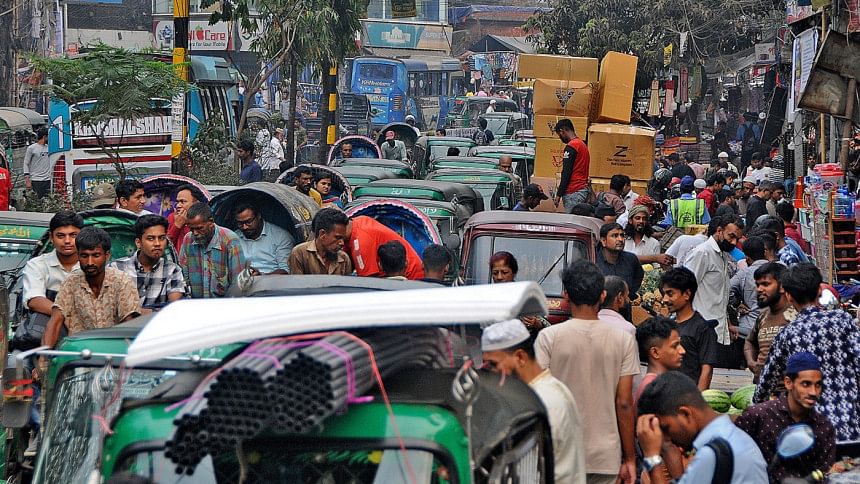Dev projects worsen Ctg traffic woes

The residents of Chattogram have been enduring severe traffic congestion due to ongoing development projects by various organisations, including Chattogram Wasa and the Chattogram Development Authority (CDA).
Additionally, a large number of unregistered vehicles, including three-wheelers and battery-run auto-rickshaws, have further strained the efforts of traffic police.
Chattogram Wasa is currently carrying out road digging and cutting as part of Package-1 of the Central Sewerage Treatment Plant (STP) project, which is being implemented at a cost of Tk 2,627.93 crore.
South Korean company TAEYOUNG Engineering & Construction Limited, in collaboration with CWasa, is overseeing this project in different areas of the city.
Meanwhile, the CDA is constructing ramps for a 16.5-kilometre-long elevated expressway connecting Lalkhan Bazar to Airport Road in the GEC area and Port Connecting Road, blocking a significant portion of the main roads.
Residents have been experiencing severe traffic congestion for months, with street hawkers and battery-run auto-rickshaws encroaching on busy roads, further exacerbating the gridlocks during peak hours.
In response, a coordination meeting on traffic management was held at the Chattogram Metropolitan Police (CMP) Headquarters, where several measures were discussed to mitigate congestion.
Pedestrians and commuters have complained that the construction of the elevated expressway ramp in front of BAWA School has narrowed the roads, leading to heavy congestion from GEC to the Wasa area. A similar situation prevails on the Port Connecting Road due to ramp construction. The deteriorating condition of roads has only added to the woes of thousands of commuters.
Additionally, sewerage-related roadworks by CWasa have damaged key roads in the city, including those in Agrabad, EPZ, Halishahar, and Arakan Road, leaving them in a dilapidated state.
Illegal parking on roads and footpath encroachment have further worsened the traffic situation, according to traffic officials.
A BRAC survey in 2015, citing BRTA data, reported that 11,321 trucks, 2,855 buses, 10,879 minibuses, 4,974 mini-trucks, 25,292 cars, 1,503 human haulers, 56,995 motorbikes, and 4,974 pick-ups operate on the city's streets daily.
Based on traffic counts in 2009, about 20,000–25,000 motorised vehicles, up to 40 percent of them trucks, used the highway daily. The number of motorised vehicles was expected to grow to at least 35,000 by 2020, with further increases anticipated by 2025 due to the city's expanding activities.
Speaking to The Daily Star, CMP Traffic North Zone Deputy Commissioner (DC) Joynul Abedin Tito said, "We have spoken to schools, colleges, markets, and hospital authorities to ensure that traffic congestion remains at a tolerable level."
"The market authorities have been asked to arrange parking spaces for their customers so that buyers do not leave their vehicles on the roads, causing gridlocks," he added.
CMP West Division Deputy Commissioner Niskriti Chakma said footpath vendors and illegal battery-run rickshaws are significantly contributing to traffic congestion.
"Sometimes, untoward situations arise when we try to enforce the law against them," she said.

 For all latest news, follow The Daily Star's Google News channel.
For all latest news, follow The Daily Star's Google News channel. 



Comments